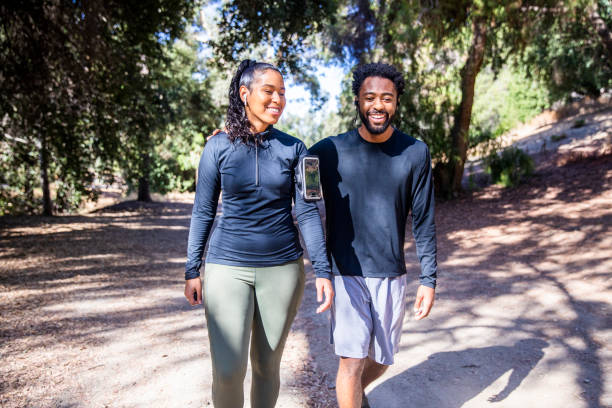(BlackFitness101.com) In the quest for fitness and health, walking stands out as a universally accessible form of exercise, embodying simplicity, effectiveness, and a low barrier to entry. This article delves into the myriad benefits of walking as an exercise, while also considering its limitations, providing a comprehensive view of its role in a balanced wellness routine.

The Stride Towards Health: Benefits of Walking
Walking is more than just a mode of transportation; it is a gateway to improved health, offering a plethora of benefits that touch on physical, mental, and emotional well-being.
Physical Health Enhancements
- Cardiovascular Improvement: Regular walking increases heart rate, strengthens the heart, and enhances blood circulation, reducing the risk of heart disease and stroke.
- Weight Management: It aids in weight loss and control by burning calories, the extent of which depends on walking speed, distance covered, and individual body weight.
- Muscle Strength and Endurance: Walking strengthens the muscles of the legs, hips, and lower back. Over time, it can improve endurance, making daily activities easier to perform.
- Joint Health: As a low-impact exercise, walking is gentle on the joints and can help alleviate symptoms of arthritis by lubricating joint surfaces and strengthening the surrounding muscles.
Mental and Emotional Well-being
- Stress Reduction: Engaging in a regular walking routine can decrease stress levels thanks to the release of endorphins, known as the body’s natural painkillers and mood elevators.
- Improved Sleep: Regular walkers often report better sleep patterns, including faster sleep onset and longer durations of deep sleep.
- Enhanced Cognitive Function: Studies suggest that walking can enhance cognitive function, reducing the risk of dementia and cognitive decline in older adults.
- Social Connection: Walking with friends or in groups can provide social support and foster a sense of community, enhancing emotional well-being.
Environmental and Economic Benefits
Walking is not only beneficial for the individual but also for the community at large. It reduces reliance on vehicles, thereby decreasing air pollution and contributing to environmental conservation. Economically, it requires no special equipment or gym memberships, making it an affordable option for maintaining fitness.
The Other Side of the Path: Drawbacks of Walking
While the benefits of walking are numerous, there are also considerations and drawbacks to bear in mind.
Limited Intensity
For those seeking high-intensity workouts or significant muscle building, walking might not suffice. It primarily targets the lower body and may require supplementation with other forms of exercise for a full-body workout.
Environmental Constraints
Walking outdoors can be affected by weather conditions, pollution, and safety concerns in certain areas. These factors can limit the consistency and enjoyment of walking as an exercise routine.
Time Consumption
Achieving significant health benefits from walking alone may require substantial time investment, as longer durations are often needed to burn the same amount of calories as other, more intense forms of exercise.
Plateau Effect
Over time, the body can become accustomed to the physical demands of walking, leading to a plateau in weight loss or fitness gains. This necessitates varying the routine, either by increasing intensity, duration, or incorporating other forms of exercise.
Maximizing the Benefits While Navigating the Drawbacks
To fully harness the advantages of walking while mitigating its limitations, consider the following strategies:
- Incorporate Variety: Integrate intervals of brisk walking or include varied terrains to increase intensity. Use stairs or hills to add challenges to your walking routine.
- Combine with Other Exercises: Supplement walking with strength training, yoga, or other aerobic exercises to target different muscle groups and prevent fitness plateaus.
- Set Realistic Goals: Establish specific, measurable, achievable, relevant, and time-bound (SMART) goals to maintain motivation and track progress.
- Stay Consistent: Consistency is key to reaping the long-term benefits of walking. Aim to walk most days of the week, adjusting the duration and intensity to fit your schedule and fitness level.
- Adapt to Conditions: For those days when outdoor walking isn’t feasible, consider indoor alternatives like mall walking, using a treadmill, or walking in place at home.
Conclusion
Walking, with its wide array of health benefits and low entry barriers, is an excellent foundation for a fitness regimen, particularly for those new to exercise or with specific health considerations. However, recognizing its limitations is crucial in crafting a well-rounded fitness plan that addresses individual goals and needs. By strategically incorporating walking into a broader exercise regimen and adopting a flexible approach to overcome its drawbacks, individuals can step confidently towards achieving their health and wellness objectives. Through this balanced perspective, walking transcends its apparent simplicity, embodying a powerful tool in the journey toward a healthier life.
Staff Writer; Leroy Smith
Questions? Feel free to email me at; LSmith@BlackFitness101.com.












Leave a Reply